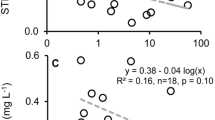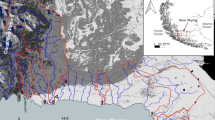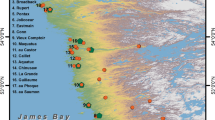Abstract
Coastal carbon cycling models remain incomplete in key continental margins worldwide. Large quantities of labile terrestrial DOC are transferred to the Gulf of Alaska in a flow of freshwater discharge from thousands of watersheds that equals the discharge of the Mississippi River. The coastal margin of southeast Alaska and British Columbia is a potential hotspot of worldwide DOC metabolism and the mass and reactivity of DOC in rivers and estuaries of the region make quantifying and modeling DOC export a priority. Scaling DOC export requires a well-constrained model of streamwater DOC concentrations. We established models for prediction of DOC streamwater concentrations through a broad sampling of streams across a large, diverse landscape in 61 independent watersheds. Stream DOC concentrations were significantly related to the amount of wetlands in a watershed confirming the necessity of understanding the fate of the mass of carbon stored within them. Several measures of slope were useful in predictive models of streamwater DOC concentrations suggesting that slope predicts the presence of wetland soils better than current wetland map layers. We also provide evidence that suggests watersheds with large salmon spawning runs have distinct characteristics that influence the relationship between wetlands and carbon cycling that may provide additional insights into how carbon is processed.




Similar content being viewed by others
References
Ågren A, Buffam I, Jansson M, Laudon H (2007) Importance of seasonality and small streams for the landscape regulation of dissolved organic carbon export. J Geophys Res 112:GO3003. doi:10.1029/2006JF000381
Aitkenhead J, McDowell W (2000) Soil C:N ratio as a predictor of annual DOC flux at local and global scales. Glob Biogeohem Cycles 14:127–138
Anderson DR, Burnham KP, Gould WR, Cherry S (2001) Concerns about finding effects that are actually spurious. Wildl Soc Bull 29:311–316
Belsley DA (1991) A guide to using the collinearity diagnostics. Comput Sci Econ Manag 4:33–50
Bilby RE, Bisson PA (1992) Allochthonous versus autochthonous organic matter contributions to the trophic support of fish populations in clear-cut and old-growth forested streams. Can J Fish Aquat Sci 49:540–551
Blöschl G, Sivapalan M (1995) Scale issues in hydrological modeling: a review. Hydrol Process 9:251–290. doi:10.1002/hyp.3360090305
Boyer EW, Hornberger GM, Bencala KE, McKnight DM (1997) Response characteristics of DOC flushing in an alpine catchment. Hydrol Process 11:1635–1647
Burnham KP, Anderson DR (2002) Model selection and multimodel inference: a practical information-theoretic approach, 2nd edn. Springer, New York
Caouette JP, Kramer MG, Nowacki GJ (2000) Deconstructing the timber volume paradigm in management of the Tongass National Forest. Gen. Tech. Rep. PNW-GTR-482. U.S. Department of Agriculture, Forest Service, Pacific Northwest Research Station, Portland, OR, p 20
Claire TA, Pollock TL, Ehrman JM (1994) Exports of carbon and nitrogen from river basins in Canada’s Atlantic Provinces. Glob Biogeochem Cycles 8:441–450
Cook RD, Weisberg S (1982) Residuals and influence in regression. Chapman and Hall, London
Creed IF, Sanford SE, Beall FD, Molot LA, Dillon PJ (2003) Cryptic wetlands: integrating hidden wetlands in regression models of the export of dissolved organic carbon from forested landscapes. Hydrol Process 17:3629–3648
D’Amore DV, Fellman JB, Edwards RT, Hood E (2010) Controls on dissolved organic matter concentrations in soils and streams from a forested wetland and sloping bog in southeast Alaska. Ecohydrology 3:249–261
D’Amore DV, Edwards RT, Herendeen PA, Hood E, Fellman JB (2015) Dissolved organic carbon fluxes from hydropedologic units in Alaskan coastal temperate rainforest watersheds. Soil Sci Soc Am J 79:698–709
Dahl TE (2006) Status and trends of wetlands in the conterminous United States 1998 to 2004. U.S. Department of the Interior, Fish and Wildlife Service, Washington, D.C
Dahm CN (1980) Studies on the distribution and fates of dissolved organic carbon. Ph.D. dissertation, Oregon State University, Corvallis, OR, p 145
Dillon PJ, Molot LA (1997) Effect of landscape form on export of dissolved organic carbon, iron, and phosphorus from forested stream catchments. Water Resour Res 33:2591–2600
Eckhardt BW, Moore TR (1990) Controls on dissolved organic carbon concentrations in streams, southern Quebec. Can J Fish Aquat Sci 47:1537–1544
Edwards RT, D’Amore DV, Norberg E, Biles FE (2013) Riparian ecology, climate change, and management in North Pacific coastal rainforests, chap 3. In: Orians G, Schoen J (eds) North Pacific temperate rainforests: ecology and conservation. University of Washington Press, Seattle, pp 43–72
Emili L, Price J, Fitzgerald D (2006) Hydrogeological influences on forest community type along forest-peatland complexes in coastal British Columbia. Can J For Res 20:2819–2837
ESRI, Environmental Systems Resource Institute (2005) ArcMap 9.1. ESRI, Redlands
Fellman JB, Hood E, Edwards RT, D’Amore DV (2008) Return of salmon-derived nutrients from the riparian zone to the stream during a storm in southeastern Alaska. Ecosystems 11:537–544
Fellman JB, Hood E, D’Amore DV, Edwards RT (2009a) Seasonal changes in the chemical quality and biodegradability of dissolved organic matter exported from soils to streams in coastal temperate rainforest watersheds. Biogeochemistry 95:277–293
Fellman JB, Hood E, Edwards RT, D’Amore DV (2009b) Changes in the concentration, biodegradability, and fluorescent properties of dissolved organic matter during stormflows in coastal temperate watersheds. J Geophys Res 114:G01021. doi:10.1029/2008JG000790
Fitzgerald DF, Price JS, de Groot A, Banner A, LePage P (2002) Surface water discharge and groundwater storage patterns in a hypermaritime bog near Prince Rupert, BC. Extension Note, Research Station, BC Ministry of Forests, Smithers
Frey KE, Smith LC (2005) Amplified carbon release from vast West Siberian peatlands by 2100. Geophys Res Lett 32:1–4
Frost P, Larson J, Johnston C, Young K, Maurice P, Lamberti G, Bridgham S (2006) Landscape predictors of stream dissolved organic matter concentration and physicochemistry in a Lake Superior river watershed. Aquat Sci 68:40–51
Gende SM, Edwards RT, Willson MF, Wipfli MS (2002) Pacific salmon in aquatic and terrestrial ecosystems. Bioscience 52:917–928
Gergel SE, Turner MG, Kratz TK (1999) Dissolved organic carbon as an indicator of the scale of watershed influence on lakes and rivers. Ecol Appl 9:1377–1390
Gibson J, Price J, Aravena D, Fitzgerald D, Maloney D (2000) Runoff generation in a hypermaritime bog-forest upland. Hydrol Process 14:2711–2730
Gorham E, Underwood J, Janssens J, Freedman B, Maass W, Waller D, Ogden J (1998) The chemistry of streams in southwestern and central Nova Scotia, with particular reference to catchment vegetation and the influence of dissolved organic carbon primarily from wetlands. Wetlands 18:115–132
Gorham E, Lehman C, Dyke A, Janssens J, Dyke L (2007) Temporal and spatial aspects of peatland initiation following deglaciation in North America. Quat Sci Rev 26:300–311
Groffmann PM, Rustad LE, Templer PH, Campbell JL, Christenson LM, Lany NK, Socci AM, Vadeboncoeur MA, Schaberg PG, Wilson GF, Driscoll CT, Fahey TJ, Fisk MC, Goodale CL, Green MB, Hamburg SP, Johnson CE, Mitchell MJ, Morse JL, Pardo LH, Rodenhouse NL (2012) Long-term integrated studies show complex and surprising effects of climate change in the northern hardwood forest. Bioscience 62:1056–1066. doi:10.1525/bio.2012.62.12.7
Holmes RM et al (2012) Seasonal and annual fluxes of nutrients and organic matter from large rivers to the Arctic ocean and surrounding seas. Estuaries Coasts 35:369–382
Hood E, Gooseff MN, Johnson SL (2006) Changes in the character of stream water dissolved organic carbon during flushing in three small watersheds, Oregon. J Geophys Res 111:G01007. doi:10.1029/2005JG000082
Hood E, Fellman JB, Edwards RT (2007) Salmon influences on dissolved organic matter in a coastal temperate brown-water stream: an application of fluorescence spectroscopy. Limnol Oceanogr 52:1580–1587
Hope D, Billett MF, Cresser MS (1994) A review of the export of carbon in river water: fluxes and processes. Environ Pollut 84:301–324
Janetski DJ, Chaloner DT, Tiegs SD, Lamberti GA (2009) Pacific salmon effects on stream ecosystems: a quantitative synthesis. Oecologia 159:583–595
Jankowski K, Schindler DE, Lisi PJ (2014) Temperature sensitivity of community respiration rates in streams is associated with watershed geomorphic features. Ecology 95:2707–2714
Johnston C, Shmagin B, Frost P, Cherrier C, Larson J, Lamberti G, Bridgham S (2008) Wetland types and wetland maps differ in ability to predict dissolved organic carbon concentrations in streams. Sci Tot Environ 404:326–334
Kreutzweiser DP, Hazlett PW, Gunn JM (2008) Logging impacts on the biogeochemistry of boreal forest soils and nutrient export to aquatic systems: a review. Environ Rev 16:157–179
Laudon H, Kohler S, Buffam I (2004) Seasonal TOC export from seven boreal catchments in northern Sweden. Aquat Sci 66:223–230
Littell RC, Milliken GA, Stroup WW, Wolfinger RD, Schabenberger A (2006) SAS for mixed models. SAS Press, Cary, p 441
Long SJ, Ervin LH (2000) Using heteroscedasticity consistent standard errors in the linear regression model. Am Stat 53:217–224
Ludwig W, Probst J-L, Kempe S (1996) Predicting the oceanic input of organic carbon by continental erosion. Glob Biogeochem Cycles 10:23–41
McClelland JW, Holmes RM, Dunton KH, Macdonald RW (2012) The Arctic ocean estuary. Estuaries Coasts 35:353–368
Mulholland PJ (1997) Dissolved organic matter concentration and flux in streams. J N Am Benthol Soc 16:131–141
Mulholland PJ (2003) Large-scale patterns in dissolved organic carbon concentration, flux, and sources, chap 6 In: Findlay S, Sinsabaugh R (eds) Aquatic ecosystems: interactivity of dissolved organic matter. Academic Press/Elsevier Science, San Diego, pp 139–159
Mulholland PJ, Kuenzler EJ (1979) Organic carbon export from upland and forested wetland watersheds. Limnol Oceanogr 24:960–966
Naiman RJ, Helfield JM, Bartz KK, Drake DC, Honea JM (2009) Pacific salmon, marine derived nutrients, and the characteristics of aquatic and riparian ecosystems. Am Fish Soc Symp 69:395–425
National Climate Assessment (2014) http://nca2014.globalchange.gov/. Accessed 15 Aug 2014
Nowacki GJ, Kramer MG (1998) The effects of wind disturbance on temperate rain forest structure and dynamics of southeast Alaska. Review Paper: General Technical Report PNW-GTR-421. USDA Forest Service, Pacific Northwest Research Station, Portland, OR
Nowacki G, Krosse P, Fisher G, Brew D, Brock T, Shephard M, Pawuk W, Baichtal J, Kissinger E (2001) Ecological subsections of southeast Alaska and neighboring areas of Canada. U.S.D.A., Forest Service, Alaska Region, Tech. Publ. R10-TP-75
Pandy S, Elliott W (2010) Suppressor variables in social work research: ways to identify in multiple regression models. J Soc Soc Work Res 1:28–40
Pastor J, Solin J, Bridgham SD, Updegraff K, Harth P, Weishampel P, Dewey B (2003) Global warming and the export of dissolved organic carbon from boreal peatlands. Oikos 100:380–386
Pinheiro JC (2006) Conditional versus marginal covariance representation for linear and nonlinear models. Austrian J Stat 35:31–44
Rasmussen JB, Godbout L, Schallenberg M (1989) The humic content of lake water and its relationship to watershed and lake morphometry. Limnol Oceanogr 34:1336–1343
Raymond PA, McClelland JW, Holmes RM, Zhulidov AV, Mull K, Peterson BJ, Striegl RB, Aiken GR, Gurtovaya TY (2007) Flux and age of dissolved organic carbon exported to the Arctic Ocean: a carbon isotopic study of the five largest arctic rivers. Glob Biogeochem Cycles GB4011. doi:10.1029/2007/GB002934
Rex JF, Petticrew EL, Albers SJ, Williams ND (2014) The influence of Pacific salmon decay products on near-field streambed sediment and organic matter dynamics: a flume simulation. Earth Surf Proc Landf 39:1378–1385
SAS/STAT® software, version 9.3 (2011) User’s guide. SAS Institute Inc., Cary, NC
Schmiege DC, Helmers AE, Bishop DM (1974) The forest ecosystem of Alaska: 8. Water. General Technical Report, PNW-GTR-028. U.S. Department of Agriculture, Forest Service, Pacific Northwest Research Station, Portland, OR, p 32
Sharpe NR, Ali A (2009) A marketing model using enhancement variables. CS-BIGS 3:23–29
Sorensen JJ, Heise BA (2008) Effects of logging on export of organic matter from headwater streams. British Columbia Forest Investment Account, Forest Science Program, project number Y081087. Final Technical Report: 2007/2008
Teisserenc R, Lucotte M, Houel S, Carreau J (2010) Integrated transfers of terrigenous organic matter to lakes at their watershed level: a combined biomarker and GIS analysis. Geochim Cosmochim Acta 74:6375–6386
Tzelgov J, Henik A (1991) Suppression situations in psychological research: definitions, implications, and applications. Psychol Bull 109:524–536
USFWS (2009) Classification of wetlands and deepwater habitats of the United States. National Wetlands Inventory website. U.S. Department of the Interior, Fish and Wildlife Service, Washington, D.C. http://www.fws.gov/wetlands
Waring RH, Franklin JF (1979) Evergreen coniferous forests of the Pacific Northwest. Science 204:1380–1386
Weisberg S (1985) Applied linear regression, 2nd edn. Wiley, New York
Weishaar JL, Aiken GR, Bergamaschi BA, Fram MS, Fujil R (2003) Evaluation of specific ultraviolet absorbance as an indicator of the chemical composition and reactivity of dissolved organic carbon. Environ Sci Technol 37:4702–4708
Wilson HF, Xenopoulos MA (2008) Ecosystem and seasonal control of stream dissolved organic carbon along a gradient of land use. Ecosystems 11:555–568
Winn N, Williamson CE, Abbitt R, Rose K, Renwick W, Henry M, Saros J (2009) Modeling dissolved organic carbon in subalpine and alpine lakes with GIS and remote sensing. Landsc Ecol 24:807–816
Wolfinger RD (1996) Heterogeneous variance: covariance structures for repeated measures. J Agric Biol Environ Stat 1:205–230
Worrall F, Burt TP (2008) The effect of severe drought on the dissolved organic carbon (DOC) concentration and flux from British rivers. J Hydrol 361:262–274
Worrall F, Burt TP, Jaeban RY, Warburton J, Shedden R (2002) Release of dissolved organic carbon from upland peat. Hydrol Process 16:3487–3504
Xenopoulos MA, Lodge DM, Frentress J, Kreps TA, Bridgham SD, Grossman E, Jackson CJ (2003) Regional comparisons of watershed determinants of dissolved organic carbon in temperate lakes from the Upper Great Lakes region and selected regions globally. Limnol Oceanogr 48:2321–2334
Acknowledgments
We would like to thank Jacob Berkowitz, Erik Norberg, Mark Lukey, Jason Fellman, and Denise Elston for field and laboratory assistance; Julianne Thompson, Emil Tucker, Jackie DeMontigny, Aaron Prussian, and Katherine Prussian for providing sampling and logistical support for extensive field campaigns; and Pat Cunningham for statistical advice. Conversations with Tim Max inspired this sample design. We would also like to thank Dom Chaloner, Chelsea Crenshaw, Pat Cunningham, and Ashley Steel for constructive comments on early drafts of the manuscript.
Author information
Authors and Affiliations
Corresponding author
Electronic supplementary material
Below is the link to the electronic supplementary material.
Rights and permissions
About this article
Cite this article
D’Amore, D.V., Edwards, R.T. & Biles, F.E. Biophysical controls on dissolved organic carbon concentrations of Alaskan coastal temperate rainforest streams. Aquat Sci 78, 381–393 (2016). https://doi.org/10.1007/s00027-015-0441-4
Received:
Accepted:
Published:
Issue Date:
DOI: https://doi.org/10.1007/s00027-015-0441-4




